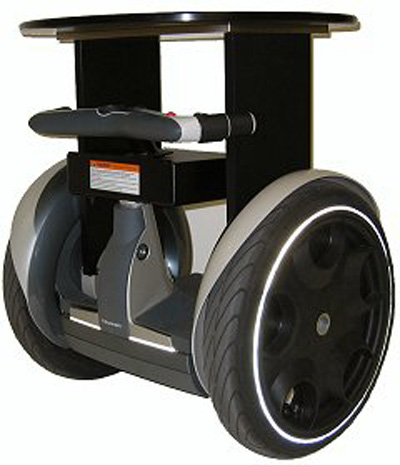Rise of the Robots: Segway Platform Gives Mechanoids Motion

A military project aimed at building smarter robots has given researchers the wheels they need to make their automatons go.
Originally developed by New Hampshire-based Segway for a Defense Advanced Research Projects Agency (DARPA) program, the firm's Robotic Mobility Platform (RMP) allows robot developers to focus more on the thinking power of their machines while providing a quick mode of transportation.
"The speed at which we can move is impressive," said Manuela Veloso, who leads the robotics CORAL research group at Carnegie Mellon University. "From a motion point of view, it's extremely reliable."
During DARPA's Mobile Autonomous Robot Software (MARS) program about 14 different research groups received Segway RMP platforms, some programmed to play soccer while others model the human brain.
"Some of the power researchers got this stuff and in about a week they had their robots rolling...it was pretty fast," said John Morrell, Segway director of systems engineering for the RMP project, in a telephone interview. "It's been really interesting to see what people have come up with."
Wheels sans robot
Segway's self-balancing robot platform takes up about 2 square feet and comes equipped with software and interface electronics necessary to receive, process and execute commands from an onboard robot payload.
Breaking space news, the latest updates on rocket launches, skywatching events and more!
"It was a minor modification to what we had," Morrell said. "The challenges for us were largely in declining to get too fancy, and keeping it really simple."
Capable of carrying 100 pounds (45 kilograms) and moving about 8 miles (12 kilometers) an hour, the platform has two different modes. Researchers can choose between its standalone function as a robot's wheels or a tractor-like mode for towing trailers or other loads.
"The goal is not to have researchers worry about transportation," Morrell said. "That way, if [a robot's computer algorithms] work on an RMP, then you could put it on a Hummer or anything else."
Upper body strength
Since Segway's RMP platform offers a utilitarian approach to robot locomotion, researchers can concentrate on software and hardware challenges such as obstacle detection and avoidance, as well as video camera-based navigation and learning skills.
"We have the motion problem solved," Veloso told SPACE.com. "So we can focus on the other aspects."
With two RMP automatons and a pair of human-carrying Segway's in her laboratory, Veloso and her research team are studying the interactions between humans and robots by separating them into soccer teams. Each side consists of one robot and one flesh and blood player, with both working together to score against their opponents.
"It's important for a vehicle to understand the complexity of being in the presence of others it cannot control," Veloso said of her soccer match-up, adding that the game builds skills that space and extreme environment robots may not need. "When we send robots to Mars, underwater volcanoes [or to a] mine, well, nobody is on Mars [now] making my life hard on purpose."
Jeffrey Krichmar, a researcher at the Neuroscience Institute in La Jolla, California, has been using the Segway RMP to drive the institute's Brain-Based Device project outdoors. The robot is designed to simulate brain functions to help researchers understand how the human brain recognizes objects and builds up memory.
"This has allowed us for the first time to get out of the lab and test the thing outdoors in an uncontrolled environment," Krichmar said of the Segway platform. "That was huge for us."
In addition to their brain studies, Krichmar and his team are working to improve human-robot interactions using soccer play as a base. The team hopes to eventually compete against Veloso's Carnegie Mellon team.
"It's more like ultimate frisbee than soccer," Krichmar said, adding that some rules could require both human and robot teammates to touch the ball before scoring. "But there's lots of safety issues...you have these 300-pound machines, which can go really fast and need to recognize to stop for humans."
Segway's robot platform has also been adopted by NASA researchers working on the humanoid automaton Robonaut B. Though Robonaut B is controlled remotely by an operator, its self-contained upper torso can be mated to the RMP platform to roll around on Earth with some moderate autonomy. Future versions could one-day help the robot's descendants explore other planets.
Better robot wheels
Despite the steady interest in Segway's robot-ready platform, there is still room for improvement, researchers said.
Current RMP models, Morrell explained, were cut from the same basic design specifications as their human-carrying counterparts. That left some excess hardware on the footplate where human passengers normally stand. A new RMP design due out by the end of the year should do away with that excess and open even more room up for robot hardware
"I believe that the ultimate use for these robot devices is in hazardous environments," Morrell said, adding that it's just a matter of finding the right application. "[Segways] can take an awful lot of abuse."

Tariq is the award-winning Editor-in-Chief of Space.com and joined the team in 2001. He covers human spaceflight, as well as skywatching and entertainment. He became Space.com's Editor-in-Chief in 2019. Before joining Space.com, Tariq was a staff reporter for The Los Angeles Times covering education and city beats in La Habra, Fullerton and Huntington Beach. He's a recipient of the 2022 Harry Kolcum Award for excellence in space reporting and the 2025 Space Pioneer Award from the National Space Society. He is an Eagle Scout and Space Camp alum with journalism degrees from the USC and NYU. You can find Tariq at Space.com and as the co-host to the This Week In Space podcast on the TWiT network. To see his latest project, you can follow Tariq on Twitter @tariqjmalik.
